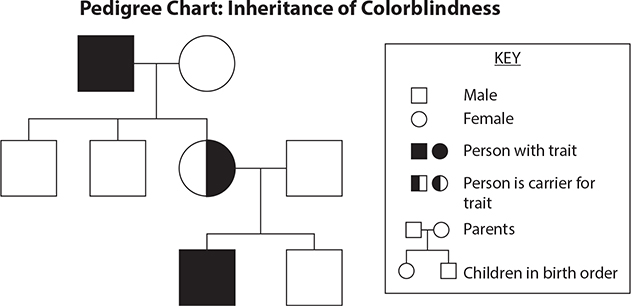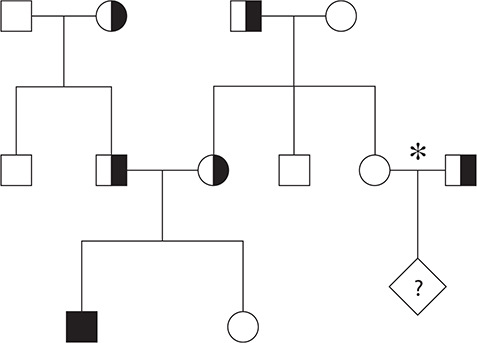CHAPTER 3
Heredity
DNA and Chromosomes
A cell uses the instructions in its deoxyribonucleic acid (DNA) to make substances called proteins. Proteins are responsible for producing physical traits such as eye color.
A gene is a segment of DNA that codes for a specific protein. Look at the following diagram of DNA. DNA is made up of pairs of four chemical bases. The specific sequence of bases in a gene determines the protein it makes.

The process of using a gene to make a protein happens in two major steps shown in the following diagram. First, the gene is transcribed into a molecule called ribonucleic acid (RNA). The RNA carries the gene’s sequence to a cell structure called a ribosome, where a protein is built. This process of DNA to RNA to protein is so specific and key in living things that it is referred to as the central dogma of biology or central dogma of molecular biology.

Children typically exhibit a mixture of traits from both of their parents. You might have, for example, your mother’s eye color and your father’s face shape. When people and other organisms reproduce, they pass on traits to their children through their DNA.
Chromosomes
Reproductive cells contain DNA in the form of structures called chromosomes. Look at the following diagram. When an egg and sperm cell unite, they create a new organism with a complete set of chromosomes, half from the mother and half from the father. Your mixture of traits is the result of the specific genes you inherited from each of your parents. In humans, normal body cells each contain 46 chromosomes. By contrast, reproductive cells each contain only 23 chromosomes.

The chromosomes that store DNA are located inside a cell’s nucleus. Look at the following diagram of a chromosome. A chromosome consists of two identical chromatids attached to each other. The location where the chromatids attach is called the centromere. Hundreds or even thousands of genes can be stored on one chromosome.

Remember that during meiosis, the chromosome splits apart into individual, but identical, chromatids. This means that the reproductive cells created during meiosis each receive one chromatid, containing one copy of every gene.
EXERCISE 1
DNA and Chromosomes
Directions: Choose the best answer for each of the following items.
1. Complete the statement with terms from the section.
To produce a trait, DNA in the nucleus is converted to ____________________, which is used to build a ____________________.
2. A normal human body cell contains 46 total chromosomes. When reproductive cells (egg and sperm cells) unite, how many total chromosomes exist in the new cell they create?
A. 2
B. 23
C. 46
D. 92
3. Which statement about chromosomes is NOT true?
A. Chromosomes are stored in the nucleus of a cell.
B. A chromosome has different genes on each chromatid.
C. Chromosomes split apart into chromatids during meiosis.
D. A single chromosome can contain over a thousand genes.
Answers are on page 658.
Alleles and Traits
Alleles are different versions of a gene. Most genes have two alleles, though more alleles are possible. One of the human eye color genes has two alleles: brown and blue. One of the human blood type genes has three alleles: A, B, and O.
New alleles for a gene are created by mutations. A mutation is a random change in the base sequence of a gene. The following diagram shows different types of mutations that can lead to new alleles.

Assortment of Alleles
Recall that at the beginning of meiosis, a cell has two copies of each chromosome. Before the chromosomes are separated and new cells are formed, they go through a process called crossing over. Look at the following diagram. An arm from each chromosome literally “crosses over” the other, allowing the arms to trade segments. Notice in the diagram that the chromosomes have traded alleles of the “B” gene.

Look at the two chromosomes shown on the right side of the following diagram. Each chromosome is now made up of one original chromatid and one chromatid with a new combination of alleles. When these four unique chromatids separate during meiosis, no two reproductive cells will have the same combination of alleles.
Environmental Altering of Traits
Some traits, like your blood type, are the direct result of the alleles you inherited from your parents. Your blood type is genetically determined, and it cannot be changed. Other traits are the result of a combination of your alleles and environmental factors. The following table describes three examples of traits that are linked to specific genes but can be altered by the environment.

Expression of Traits
When a gene is actively being used to make a protein, the gene is said to be turned on, or “expressed.” The genes for some traits are expressed all the time. Others are only turned on when a specific protein is needed. The study of how genes are turned off and on is called epigenetics.
Environmental factors like temperature can also directly affect which genes are expressed. Color spots on the face, ears, feet, and tail of Siamese cats are a good example. In Siamese cats, hair on warm parts of the body stays light-colored, and hair on cool parts of the body is dark-colored. This is because the hair color gene is expressed only in areas below a certain temperature.

EXERCISE 2
Alleles and Traits
Directions: Choose the best answer for each of the following items.
1. The addition of an extra base to a segment of DNA produces a new
A. trait.
B. gene.
C. allele.
D. chromosome.
Question 2 is based on the following diagram.

2. Look at the pair of chromosomes shown. What evidence indicates that crossing over has occurred?
A. The two chromosomes contain different alleles of genes A, B, and C.
B. The two inside chromatids contain different alleles of genes A, B, and C.
C. The two outside chromatids contain different alleles of genes A, B, and C.
D. The first chromosome’s two chromatids contain different alleles of gene C.
3. Which of the following is NOT an example of the environment altering the expression of a trait?
A. A temperature of 80°F in an alligator’s nest causes the eggs to hatch as females.
B. Providing too much oxygen to a premature baby can cause blindness.
C. Lizards absorb heat from warm surfaces instead of producing body heat.
D. A hot climate prevents pigment from being produced in the fur of Himalayan rabbits.
Answers are on page 658.
Simple Inheritance
Remember that you have two copies of every gene—one inherited from your mother and one from your father. Your combination of alleles for a specific gene is called your genotype. Your physical appearance for a trait is called your phenotype. Your genotype determines your phenotype.
In simple inheritance, a gene has two alleles (versions). The two alleles are represented by a capital and lowercase letter. The following diagram shows the possible genotypes and phenotypes for the human eye color gene. (Although there are several different genes that affect human eye color, we will focus only on the blue/brown gene.)

In simple inheritance, a gene has a dominant and a recessive allele. If a person has at least one copy of the dominant allele (represented by a capital letter), he or she will have the dominant phenotype. A recessive phenotype requires two copies of the recessive allele (represented by a lowercase letter). Notice in the diagram that brown eye color is dominant and blue eye color is recessive.
Probability of Inheriting Traits
A Punnett square is a chart used to calculate the probability of parents passing on a trait to their child. When using a Punnett square, remember:
• One parent’s alleles go along the top and one parent’s alleles go along the left side of the Punnett square.
• The parents’ alleles are matched up inside each box to show all of the allele combinations (genotypes) that the child could receive.
• The child has a 25 percent chance of inheriting the combination in each box.

Recall that brown eyes are dominant over blue eyes. The Punnett square shows the eye color probabilities for the child of a brown-eyed father (Bb) and a blue-eyed mother (bb). The child has a 50 percent chance of having brown eyes (Bb) and a 50 percent chance of having blue eyes (bb).
A pedigree chart is used to trace the inheritance of a trait through the generations of a family. This type of chart is often used to study genetic disorders such as colorblindness.
The following pedigree chart traces the inheritance of colorblindness through three generations of a family. Notice the meaning of the different symbols in the key. Colorblindness is a recessive trait. The person with the half-shaded symbol is called a “carrier” because she has one copy of the recessive colorblindness allele and one copy of the dominant color vision allele. She is not colorblind, but she can pass the colorblindness allele on to her child.

EXERCISE 3
Simple Inheritance
Directions: Choose the best answer for each of the following items.
Questions 1 through 4 are based on the following information and diagram.
Cystic fibrosis is a genetic disease. The cystic fibrosis allele (c) is recessive to the healthy allele (C). The following pedigree chart shows the inheritance of the cystic fibrosis allele through three generations of a family.

1. What does the text mean when it says that the cystic fibrosis allele is recessive to the healthy allele?
A. Cystic fibrosis is not a common condition.
B. Healthy alleles are always passed down, rather than recessive alleles.
C. If the recessive gene is present, the offspring will inherit it.
D. To have a recessive gene expressed, offspring must inherit the recessive gene from both parents.
2. How can the person represented by the solid square at the bottom of the pedigree chart best be described?
A. a healthy female
B. a male with cystic fibrosis
C. a male who is a carrier for cystic fibrosis
D. a female with an unknown allele combination
3. Place an X on the pedigree chart to indicate each person who has the genotype CC.
4. The asterisk (*) in the pedigree chart indicates a couple who are planning to start a family. They want to know their chances of having a child with cystic fibrosis. Write a brief explanation of the chart for the couple, including a Punnett square and the percent probability of their having a child with the disease.